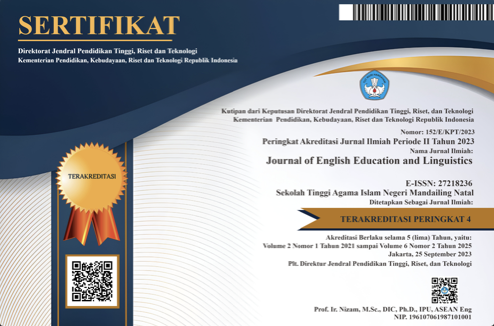TRANSLATION, WHY IS THIS DIFFICULT? STUDENTS’ DIFFICULTIES IN TRANSLATING ENGLISH TEXT
DOI:
https://doi.org/10.56874/jeel.v3i1.773Keywords:
Translation, Translation DifficultiesAbstract
The purpose of this research was to describe the difficulties in translating text, the type of error in translation and the factors cause it in translation at Muhammadiyah Lampung University Students. The subject of this research were Muhammadiyah Lampung University at fourth semester in English Education Department. The data collecting technique of this research used test and questionnaire. The result of this research indicated that students have some difficulties in Translation Subject such as (1) Elliptical Error (12%), Idioms (57%), and textual meaning ( 31%). Based on the data the majority students indicated that Idioms is the most difficulties in Translation English Text.
References
Anari, S. M. dan Bouali, Z. (2009) Naturalness and Accuracy in English Translation of Hāfiz. Journal of Teaching English as a Foreign Language and Literature, 1(3), hlm 75- 85.
Bradeau, Ligia. (2012). Defining features of idioms: ‘Stumbling Blocks’ in the process of translation. Studia UBB Philologia, LVII,3, 2012.
Budianto, L. and A. E. Fardhani. 2010. A Practical Guide for Translation Skill. Malang. UIN-Maliki Press
CRISTEA, Teodora,(2000) Stratégies de la traduction, București: Editura Fundației România de mâine
Fitriyah, F., Emzir, E., & Ridwan, S. (2019). Cultural Values of Politeness in Efl Classroom: A Study of Ethnography of Communication. Language Literacy: Journal of Linguistics, Literature, and Language Teaching, 3(2), 207–216. https://doi.org/10.30743/ll.v3i2.1965
Griffiths, Patrick. 2006. An Introduction to English Semantics and Pragmatics. Edinburgh: Edinburgh University Press
Gouadec, Darriel. 2007. Translation as a Profession. Amsterdam: John Benjamin Publishing Company
Halai, N, (2007). Making use of bilingual interview data: Some expressions from the field. Qualitative Research Report, 12(3) 344–355.
Langlotz, Andreas. (2006). Idiomatic creativity: a cognitive-linguistics model of idiom- representation and idiom-variation in english. Philadelphia: John Benjamins
Publishing Company.
Maingueneau, Dominique. 1991. Analyse du discours: Introduction aux lectures de l’archive.
Paris: Hachette.
Meryem, M. (2010). Problems of idioms in translation, case study: First year
master. Mentouri University: Constantine.
Munday, Jeremy. (2004). Introducing Translation Studies: Theories and applications.
London: Routledge
Nababan, M.R. (2008) Kompetensi Penerjemahan dan Dampaknya pada Kualitas
Terjemahan. Pidato Pengukuhan Guru Besar Bidang Penerjemahan Universitas Sebelas
Maret. Surakarta: Universitas Sebelas Maret.
Newmark, P. (1991). About translation. Australia: Multilingual Ltd.
Robinson, D. (2003). Becoming a translator. London: Routledge
Sugiyono. (2007). Metode penelitian pendidikan. Bandung : Alfabeta. Sukmana, W. (2000). The English – Indonesian translation skills. University of
Bengkulu: Unpublished thesis.
Suksaereseup, N. & Thep-Ackrapong, T. (2009). Errors found in translation
from English to Thai. Translation Journal. 13(1).
Saragih, A. E. (2020). The Translation of Phrasal Verbs in Thirteen Reasons Why. Language
Literacy: Journal of Linguistics, Literature, and Language Teaching, 4(1), 160–167.
https://doi.org/10.30743/ll.v4i1.2307
Venuti, Lawrence. 2000. Ed. The Translation Studies Reader. London: Routledge.
Downloads
Published
Issue
Section
License
All articles published in the Journal of English Education and Linguistics are licensed under a Creative Commons Attribution-ShareAlike 4.0 International (CC BY-SA) license. This means anyone is free to copy, transform, or redistribute articles for any lawful purpose in any medium, provided they give appropriate attribution to the original author(s) and Journal of English Education and Linguistics, link to the license, indicate if changes were made, and redistribute any derivative work under the same license.
Copyright on articles is retained by the respective author(s) without restrictions. A non-exclusive license is granted to the Journal of English Education and Linguistics to publish the article and identify itself as its original publisher, along with the commercial right to include the article in a hardcopy issue for sale to libraries and individuals.
Although the conditions of the Creative Commons Attribution-ShareAlike 4.0 International (CC BY-SA) license do not apply to authors (as the copyright holder of your article, you have no restrictions on your rights), by submitting to the Journal of English Education and Linguistics, authors recognize the rights of readers and must grant any third party the right to use their articles to the extent provided by the license.

This work is licensed under a Creative Commons Attribution-ShareAlike 4.0 International License.








